Regional Dominance Shifts: Key Changes in the Global Order
Updated On: October 23, 2025 by Aaron Connolly
Core Concepts of Regional Dominance Shifts
Regional dominance shifts pop up when old powers lose their grip and new ones step in to control their neighborhoods. These changes shake up trade routes, military alliances, and economic partnerships, all of which mess with global stability.
Defining Regional Dominance
Regional dominance is basically when one country calls the shots in its area. This usually comes from a mix of economic muscle, military strength, and political leadership.
A dominant regional power pushes key decisions in its neighborhood. They set the tone for security, trade, and diplomacy with nearby countries.
You’ll usually see three main regional strategies:
- Empire: Taking direct control, sometimes by force
- Hegemony: Using economic or political pressure
- Leadership: Building partnerships and cooperating with willing neighbors
The United States led North America for ages. Now China’s trying out a similar playbook in East Asia, using both investment and military moves.
Regional powers often start off as middleweights before they bulk up. Brazil, for example, leads South America mostly through trade, not force.
Several things can boost regional dominance. Economic resources, where a country sits on the map, and its military all matter. Culture and diplomatic skills? Those count too.
Understanding Shifts in Global Power
Power shifts happen when new countries start challenging the old regional bosses. Economic growth, modern militaries, and clever partnerships drive these changes.
Since World War II, the world’s political map has changed a ton. Western powers once ran most regions with colonies or economic dominance.
Some big reasons behind power shifts:
- Economic crises that hit established powers
- Developing nations boosting their GDP
- New military tech changing the rules
- Trade routes shifting and shaking up influence
Domestic troubles can knock a country’s regional clout down fast. Recession, corruption, or social unrest can eat up resources needed for leadership.
Sometimes, several powers fight over the same region. This competition brings tension—and sometimes conflict, as we’ve seen with today’s big players.
The move from Western to Eastern power centers is probably the biggest shift in today’s geopolitics. Asian countries now push back against the old European and American dominance.
Geopolitical Landscape Transformation
Right now, the geopolitical scene is changing in big ways. Western dominance is under pressure from rising powers all over the map.
China’s economic boom has set up a new power hub in Asia. Russia still holds sway in Eastern Europe and Central Asia, even with sanctions biting.
Here are some current regional power contests:
- US vs. China in the Pacific
- Russia vs. EU in Eastern Europe
- India vs. China in South Asia
- Turkey vs. old-school powers in the Middle East
All these rivalries feed instability—think proxy wars and economic fights. Trade spats, military buildups, and diplomatic drama are getting more common.
Tech is a major player now. Cyber skills, space programs, and advanced weapons give countries new ways to flex.
Regional groups like ASEAN, the African Union, and BRICS are popping up to counterbalance Western clubs. They build new power networks outside the old systems.
The landscape keeps shifting as climate change, resource shortages, and population changes stir the pot. Whoever leads next will have to juggle all these challenges and still hold onto power.
Historical Background of Regional Power Transitions
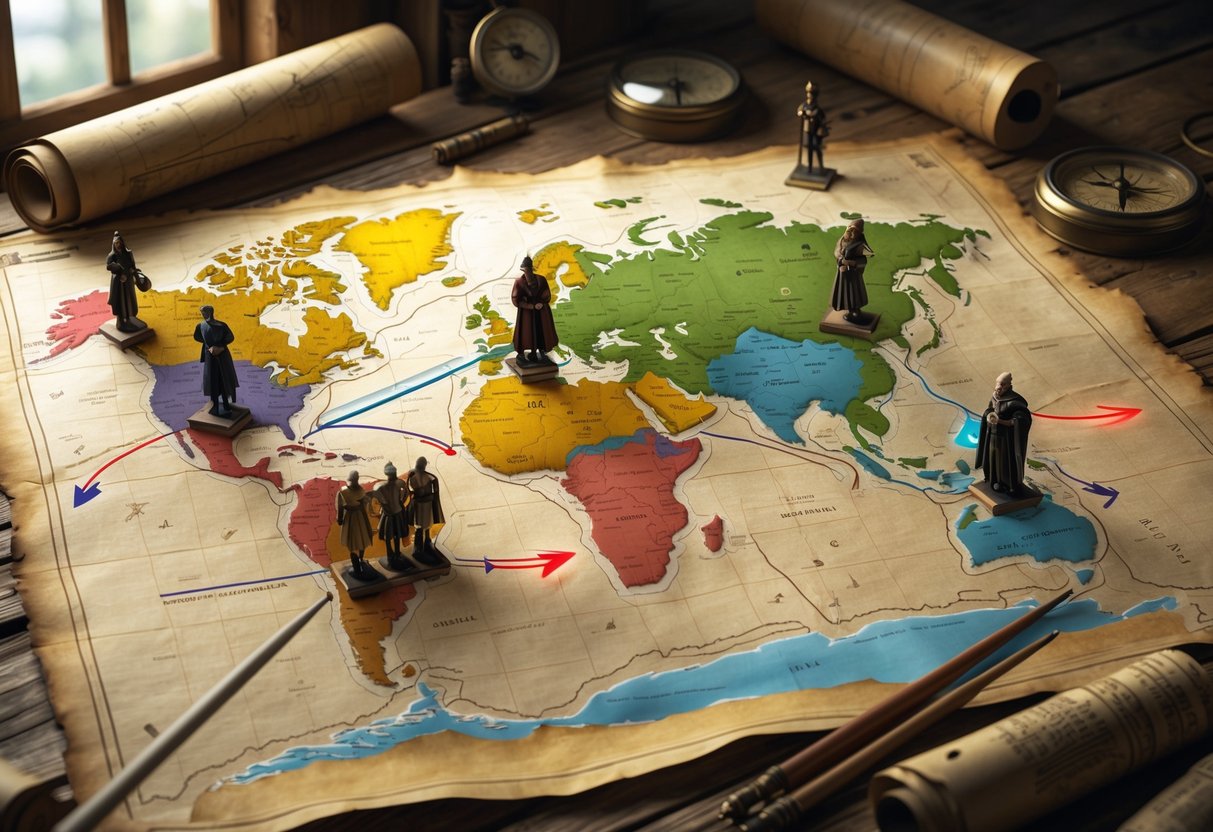
Three major forces have shaped modern geopolitics through regional power shifts. The Cold War’s end broke up old power blocks, decolonization created new states hungry for influence, and shifting alliances changed how regions organize for security and trade.
Legacy of the Cold War
The Cold War set up some pretty strict regional power lines. NATO became the top Western alliance, tying Europe and North America together under US leadership.
The Soviets built their own system in Eastern Europe with the Warsaw Pact. This split the world into clear zones of influence.
When the Soviet Union fell in 1991, big power gaps opened up. Eastern Europe suddenly had to find its own way, free from Moscow but unsure of new security options.
NATO expansion drove the next big realignment. Countries like Poland, Hungary, and the Czech Republic joined up in 1999, shaking up Europe’s power map.
With superpowers out of the picture, regional powers started stepping up. Local conflicts took on new life as emerging leaders filled the gaps.
Post-Colonial Dynamics
Decolonization in the mid-1900s brought waves of new countries. Right away, they started competing for regional influence and resources.
Africa saw new powers like Nigeria, South Africa, and Egypt trying to lead their corners, using either economic or military strength.
Post-colonial borders often ignored local divisions. That’s led to ongoing conflicts that still shape regional power.
Old colonial powers didn’t just leave quietly. They kept their grip through trade and military deals—France’s continued presence in West Africa is a classic example.
In the Middle East, things shifted as Europeans left. Iran, Saudi Arabia, and Israel rose as the big regional players.
| Region | Emerging Powers | Colonial Legacy Impact |
|---|---|---|
| West Africa | Nigeria | French economic influence |
| Southern Africa | South Africa | Apartheid isolation |
| Middle East | Iran, Saudi Arabia | British mandate borders |
Evolution of Global Alliances
Alliances have changed a lot since the Cold War. NATO shifted from just defending against the Soviets to handling crises and global security.
New regional blocs sprang up to challenge the West. The BRICS group built alternative economic and political systems.
Europe built up its own muscle with the EU, cutting some reliance on the US but still keeping Atlantic ties.
Economic partnerships started to matter more than old military ones. ASEAN, for example, focuses on Southeast Asian trade, not just defense.
Regional powers now form their own alliance webs. China’s Belt and Road Initiative is creating new influence zones across continents.
Modern alliances are way more flexible. Countries juggle multiple partnerships instead of picking one side and sticking to it.
The Rise of Asia and Changing Power Structures
Asia sits at the heart of today’s global power changes. China’s economic surge is challenging US dominance, while India is stepping up as a key player. Japan still wields influence through tech and alliances, and Australia anchors Western partnerships with moves like the Quad.
China’s Expanding Influence
China’s economic rocket ride over the last thirty years has flipped Asia’s power balance. Beijing now pushes back against the US-led system that’s dominated since the Cold War.
China uses what some call a “dual structure” approach. The country leads economic projects through its own institutions and builds up military forces in hot spots.
Economic Leadership:
- Belt and Road Initiative linking Asian economies
- Regional Comprehensive Economic Partnership membership
- More trade deals with ASEAN countries
China’s military has modernized right alongside its economy. The Navy now sails advanced ships in the South China Sea, which is making other countries nervous.
Beijing also sets up multilateral groups that leave out Western allies. These give countries a way to get development money without the usual strings attached.
India’s Strategic Position
India stands as Asia’s big democratic counterweight to China’s more authoritarian style. Its growing economy and strategic location make it hard to ignore.
India balances between working with and competing against China. They clash for influence, but still keep up big trade ties.
India’s Strategic Assets:
- World’s largest democracy
- Fast-growing economy
- Sits between East and West
- Rising tech sector
India plays the alliance game with finesse. It keeps old ties with Russia but also cozies up to Western democracies through the Quad.
India’s young population could be its secret weapon. Unlike China, which is aging fast, India has a demographic edge for the future.
The Role of Japan
Japan keeps its influence alive despite some economic bumps, mostly through tech and smart alliances. Tokyo is a key US ally but also builds its own regional relationships.
Japan mixes economic engagement with security moves. It trades a lot with China but is also beefing up its military in case things get dicey.
Japan’s Key Strengths:
- Cutting-edge tech and manufacturing
- Strong US alliance
- Big on development aid
- Strong maritime security
Tokyo has started spending more on defense and is rethinking old military limits. These moves show its worries about regional threats.
Japan’s soft power is still a big deal—think culture and innovation. That helps balance out its formal alliances and business ties.
Australia and the Quad
Australia holds down Western influence in the Asia-Pacific, mostly through the Quad with the US, Japan, and India. This group stands up for democracy in a region that’s getting more contested by the day.
The Quad isn’t a formal military alliance. Instead, members team up on things like maritime security, tech standards, and infrastructure.
Quad Cooperation Areas:
- Watching the seas together
- Setting tech standards
- Building infrastructure
- Pandemic response
Australia’s spot on the map makes it crucial for Western countries wanting access to Asian markets. It tries to walk a fine line—relying on China for trade but sticking with security partners who share its values.
Recent Aussie policies show just how tricky this balancing act is. Canberra has blocked some Chinese investments in sensitive areas but still trades heavily with China.
United States and the Redistribution of Global Influence
The United States is dealing with real challenges to its global leadership. New powers are shifting the rules, and internal struggles are chipping away at American influence abroad. The US is tweaking its military spending and economic strategies to keep up.
US Leadership and Decline
America’s spot as the world’s top superpower isn’t as secure as it used to be. After decades of leading the pack, we’re now seeing a move toward a multipolar world.
China’s rapid rise has built the world’s second-biggest economy. The Belt and Road project is a clear shot at US influence, connecting Asia, Africa, and Europe.
India is also stepping up. Its tech sector is booming, and millions have climbed out of poverty, giving India a stronger voice globally.
America’s internal issues make things worse. Economic inequality is growing, and political divides are deepening. Foreign policy mistakes have made some allies wonder if the US is still reliable.
The dollar is still the world’s main reserve currency, but alternatives are popping up. Some countries are actively trying to cut their reliance on the dollar.
Impacts of American Policy Shifts
Recent policies show America’s struggle to keep its influence. Trade wars and tariffs have strained old alliances, sometimes pushing partners to look elsewhere.
The US is rethinking its military commitments. Pulling troops out of Afghanistan and Iraq signaled a move away from direct interventions.
Diplomatic ties are getting rocky. Longtime allies question if America will show up when it counts. The “America First” approach has made multilateral cooperation harder.
Some of the biggest impacts:
- NATO isn’t as tight as it used to be
- Less sway in global organizations
- Damaged trade relationships
- Softer cultural influence
Climate policy shifts add another layer of trouble. Other countries are taking the lead on environmental issues, which chips away at US credibility.
Economic sanctions are still a favorite tool. But as targeted nations build their own systems, sanctions don’t always work as planned. Russia and China, for example, have set up parallel financial networks.
Military and Economic Strategy
The US still spends more on defense than anyone—over $800 billion a year, which is more than the next ten countries combined.
Arms sales keep America influential. US-made weapons are everywhere.
Major buyers include:
| Region | Key Buyers | Primary Systems |
|---|---|---|
| Middle East | Saudi Arabia, UAE | Fighter jets, missile defense |
| Asia-Pacific | Japan, Australia | Naval systems, aircraft |
| Europe | UK, Poland | Advanced weaponry, logistics |
The Pentagon now focuses on big rivals like China and Russia, moving away from the old counterterrorism missions.
Tech is front and center in economic strategy. The US restricts semiconductors to slow China’s progress and uses export controls to keep its edge.
The military-industrial sector is shifting too. Space and cyber warfare are getting more attention, since those could be the next frontiers.
Some alliances are getting stronger, like AUKUS with Australia and the UK. The Quad is another move to balance China in the Pacific.
But let’s be honest—military might alone won’t solve the redistribution puzzle. The US needs to stay competitive economically and keep up smart diplomacy if it wants to hold onto its global influence.
European Response to Shifting Regional Dynamics

Europe keeps adjusting to big geopolitical changes. Military cooperation, economic independence, and the growing Eastern European influence are all playing a part.
These shifts are changing how the European Union and NATO work in a world that’s honestly more fragmented than ever.
European Military Consolidation
NATO has really beefed up its eastern flank since 2022. The alliance sent more than 40,000 extra troops to Poland, the Baltic states, and Romania.
Defence spending is way up across Europe. Germany finally hit a defence budget of 2% of GDP, something it hadn’t done since the Cold War.
Poland now spends 4% of its GDP on defence, making it the top spender in NATO by percentage.
Joint military programmes are popping up everywhere. The European Union rolled out the European Peace Facility with €12 billion behind it.
France and Germany teamed up to work on the Future Combat Air System.
Key Defence Initiatives:
- European Sky Shield Initiative (21 nations involved)
- Joint buying of ammunition and air defence systems
- Enhanced Forward Presence battalions in Eastern Europe
- Permanent naval task forces in the Baltic and Black Seas
Strategic Autonomy Initiatives
The European Union wants to rely less on outside powers. Targeted economic policies are pushing that shift.
We’re watching the EU move away from wide-open markets to protecting key sectors.
Sourcing critical raw materials now tops the list. The EU’s Critical Raw Materials Act says 15% of annual use should come from inside Europe by 2030.
New deals with African and Latin American countries are replacing old single-supplier habits.
Digital sovereignty is picking up speed. The EU put €7.5 billion into new microchip factories.
We’re also seeing new limits on tech transfers to certain regions.
Trade diversification is moving fast. EU trade with Asia-Pacific nations jumped 23% in 2024.
At the same time, traditional partners are facing more conditions and screening.
Eastern Europe and Power Realignment
Eastern Europe is stepping up in EU decision-making. Poland leads the way with bigger military budgets and strong backing for Ukraine.
Hungary takes a different path, mixing conservative domestic policies with pragmatic foreign moves. That sometimes causes tension, but it also gives the EU other diplomatic options.
The Visegrád Group isn’t as tight as it used to be. Now, Poland, the Baltic states, and Nordic countries are working together on security.
We’re seeing a power shift eastward. Western European countries are distracted with their own politics, and Eastern Europe is filling the gaps, especially on defence and energy.
Regional priorities from the east are shaping EU-wide policies more than before. Eastern states pushed hard for stricter sanctions and more military aid.
Russian Strategies Amidst Regional Dominance Shifts
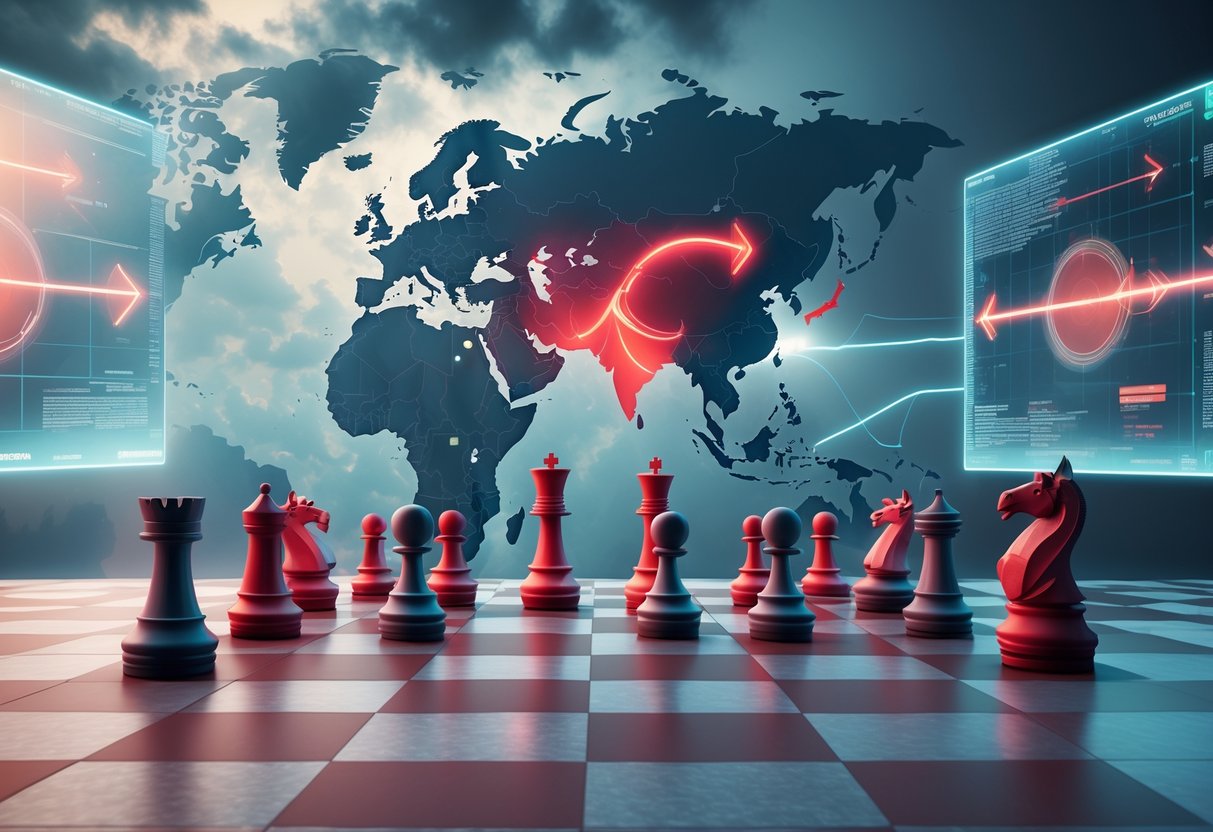
Russia has overhauled its global approach as Western isolation forces new strategies. The Kremlin now faces less influence in Eastern Europe, but it’s diving deeper into the Middle East and building up Asian partnerships.
Strained Influence in Eastern Europe
Russia’s invasion of Ukraine has badly damaged its standing in Eastern Europe. Former allies have pulled away from Moscow’s orbit.
The war pushed the Kremlin to tighten its grip at home. Moscow took direct control over regional governments and economic resources.
That move has sparked tension with local elites who used to have more freedom.
Key changes include:
- Moscow now controls regional budgets directly
- The government nationalised business assets for war production
- Regional governors have to meet new performance targets
Eastern European countries that once played it safe with Russia now openly support Ukraine. Poland, the Baltic states, and the Czech Republic have become some of Russia’s loudest critics.
The economic fallout is real. Regions that depended on Western trade are struggling to rebuild supply chains.
Manufacturing areas with foreign investment, especially in the auto sector, have run into big disruptions.
Moscow’s answer? More authoritarian controls. The government set up “medium level of readiness” protocols in border areas.
These rules allow for forced resettlement and tight movement restrictions.
Engagement in the Middle East
Russia has ramped up its Middle Eastern game to make up for losing ground in Europe. This strategy builds on its military moves in Syria starting back in 2015.
Russian Middle East priorities:
- Signing new military cooperation deals
- Building energy export partnerships
- Selling arms to regional powers
- Securing maritime access through the Black Sea
The Black Sea is now central to Russia’s Middle East plans. Controlling it gives Moscow a launchpad for Mediterranean operations.
Russian naval forces back up commitments in Syria and boost regional influence.
Energy exports are still a key lever. Russia sells natural gas and oil to several Middle Eastern countries.
These deals provide much-needed cash as Europe closes its doors.
Arms sales are up, too. Russia sells military hardware with fewer strings attached than Western suppliers.
Authoritarian governments like getting advanced weapons without the human rights lectures.
Still, the Ukraine war has strained some of these relationships. Regional players worry about Russia’s reliability as a long-term partner.
The conflict has also stretched Russia’s military resources thin in the Middle East.
Russia’s Relations with Asia
Asia has become Russia’s main strategic focus as ties with the West go cold. China leads this pivot, but India and others matter, too.
The Sino-Russian partnership keeps getting stronger. Trade volumes are up, with China buying Russian energy at a discount.
Military cooperation has grown, with more joint exercises and tech sharing.
Asian engagement includes:
- Building new trade routes and infrastructure
- Partnering on Arctic shipping
- Signing technology transfer deals
- Creating alternative payment systems to dodge Western sanctions
Russia has poured money into developing its Far East and Siberian transport links. These investments help shift trade away from Europe.
The Northern Sea Route is now a big deal for Asian trade.
India plays a balancing act. New Delhi keeps buying Russian oil, even while working with Western partners.
This gives Russia a steady market and helps India with energy security.
Central Asian relationships are changing, too. Russia still has influence, but the war opened the door for other powers.
China’s Belt and Road Initiative now competes directly with Russia in the region.
Russia faces a tricky task: building ties with Asian partners without becoming too dependent on China.
Beijing’s growing clout in Central Asia worries Moscow, which doesn’t want to lose its traditional sphere of control.
The Middle East: Case Study in Shifting Power Balances
The Middle East is a great example of how fast power can swing between countries and groups. Recent events have shaken up who leads and how they compete.
Arab Spring and Aftermath
The Arab Spring kicked off in 2010 and turned the region upside down. Uprisings swept through Tunisia, Egypt, Libya, and Syria.
Key Changes:
- Old regimes toppled in several places
- Civil wars erupted in Syria, Libya, and Yemen
- New political groups rose to power
- Iran grabbed more influence through proxy groups
The chaos left power vacuums everywhere. Iran stepped in, backing Hezbollah in Lebanon and militias in Iraq.
This move gave Iran a bigger regional footprint.
Syria’s civil war became a messy battleground. Iran supported President Assad, while other countries backed the rebels.
The conflict drew in Russia, Turkey, and the United States.
Jordan managed to steer clear of major unrest. The kingdom made a few reforms and leaned on security forces to keep things stable.
That made Jordan a key ally for Western nations.
Afterward, new alliances and rivalries formed. Old power structures crumbled.
Fresh regional competitions popped up between Iran, Saudi Arabia, and others.
Saudi Arabia’s Emerging Role
Saudi Arabia changed its foreign policy game after the Arab Spring. Crown Prince Mohammed bin Salman kicked off big reforms starting in 2017.
The kingdom got more aggressive militarily. It led a coalition in Yemen’s civil war from 2015.
Saudi forces also started working more closely with Israel to counter Iran.
Economic Changes:
- Vision 2030 plan to move away from oil
- New bets on tech and tourism
- Military spending shot up
- Big regional infrastructure projects
Saudi Arabia now competes with Iran for regional leadership. The two countries back opposite sides in conflicts all over the Middle East.
The Abraham Accords in 2020 signaled a shift. Saudi Arabia didn’t sign directly, but it let Israeli flights cross its airspace.
That move broke with old Arab positions.
Lately, Saudi Arabia’s influence has grown. Iran’s shrinking power in Syria and Lebanon opens doors for the Saudis.
Iran and Regional Contestation
Iran built a “resistance axis” across the Middle East after 2003. This network covers Hezbollah, Hamas, and Shia militias in Iraq and Syria.
For a while, the strategy worked. Iran gained sway without fighting directly. Proxy groups pushed Iranian interests in Lebanon, Gaza, Iraq, and Yemen.
Iran’s Network:
- Hezbollah in Lebanon
- Houthi rebels in Yemen
- Shia militias in Iraq
- Support for Assad in Syria
But things have changed. Israeli military strikes have hit key proxy groups hard.
Assad’s regime collapsed in Syria, cutting off a major supply route.
Sanctions keep hammering Iran’s economy. The government struggles to fund its regional operations like before.
Iran’s nuclear programme still worries its neighbors and world powers. Talks drag on about limiting Iran’s nuclear work in exchange for sanctions relief.
The balance is tipping away from Iran. Saudi Arabia and Israel seem better positioned for the next round of influence battles.
China’s Belt and Road Initiative and Infrastructure Influence
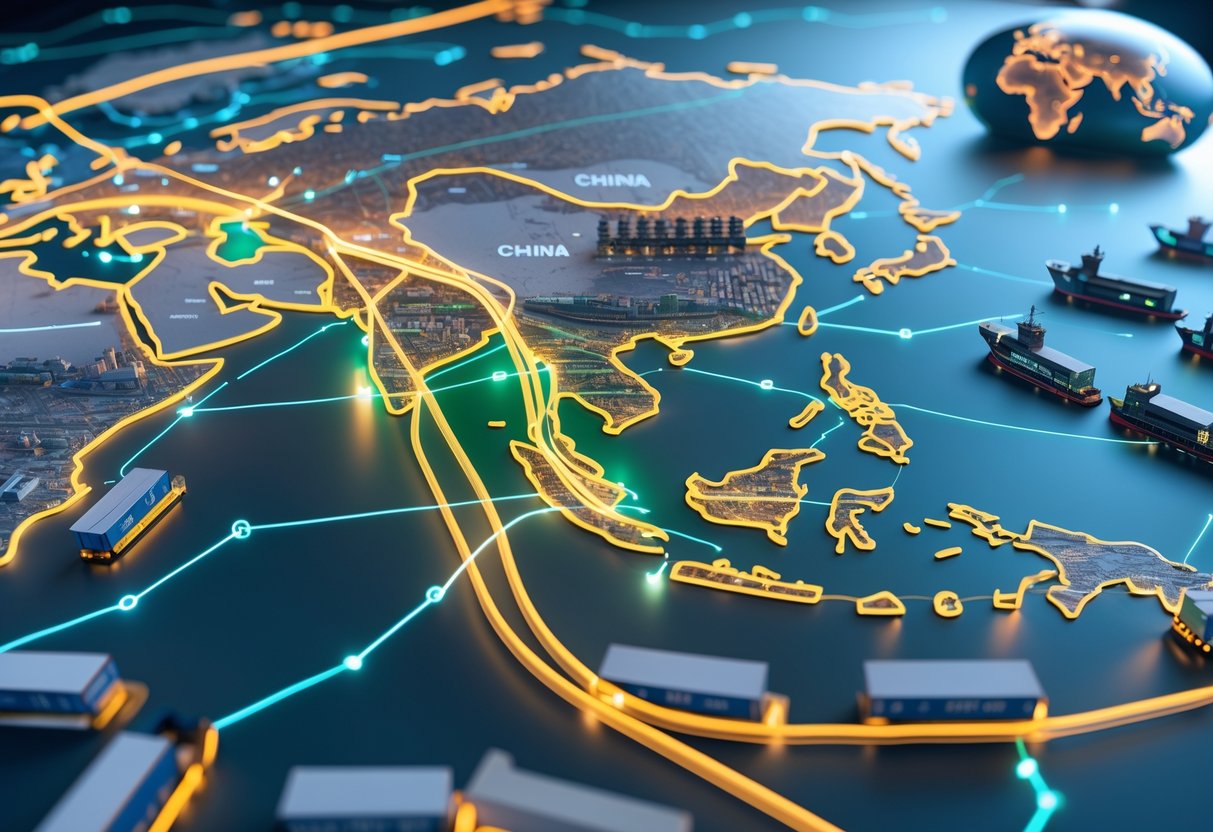
China’s Belt and Road Initiative has built new economic dependencies with huge infrastructure investments. The project also secures strategic port access on three continents.
These projects now stretch across 150+ countries, shifting regional power using economic leverage.
Expansion Across Asia and Beyond
The Belt and Road Initiative links Asia, Africa, and Europe through a giant web of infrastructure. Honestly, it’s China’s main play for global influence.
More than 150 countries have joined since 2013. Nations from all over want better infrastructure.
The programme fills a big gap in global infrastructure funding. Traditional financial institutions backed away from big projects, leaving developing countries with few options.
China’s approach is pretty different from old-school aid. The initiative runs for profit, not charity.
Key project types include:
- Railways and highways
- Energy facilities
- Telecom networks
- Ports
- Industrial parks
It started as a way for China to use up excess capacity at home. Now, it’s a full-blown geopolitical tool with clear strategic goals.
Economic Dependencies
Chinese infrastructure deals create complicated financial ties. These usually end up favoring Beijing over the long haul.
We see a lot of countries struggling with debt sustainability from these mega-projects.
China stays flexible with debt repayment. If a country can’t pay in cash, Beijing might take commodities or lease assets instead.
This approach does a few things:
- Keeps governments on China’s side
- Secures key assets
- Helps China look like a steady partner
At first, many developing countries welcome Chinese investment. But over time, more leaders worry about China’s real motives and mounting debt.
The dependency becomes obvious when countries can’t keep up with payments. China then takes over strategic infrastructure through long-term leases or management deals.
Recent cases show how debt can lead to Chinese companies controlling major assets. Western observers are getting nervous about economic sovereignty.
Strategic Port Projects
China focuses on port investments that fit its maritime and military plans. Clear patterns show these projects boost Chinese naval reach and trade route control.
Djibouti stands out as China’s biggest strategic win. The port hosts China’s first overseas military base and gives access to the Red Sea.
Strategic benefits include:
- Control of major shipping lanes
- Stronger naval presence
- Access to resources
- Influence over regional trade
China targets ports near key maritime chokepoints. These spots let Beijing control global shipping if things get tense.
Western security experts worry about the dual-use angle. Commercial ports can quickly host military ships and surveillance gear.
Host countries often find out—sometimes too late—that Chinese companies gradually take over operations.
This shift usually happens through management deals and technical support requirements.
Impact of Economic Sanctions on Regional Dynamics
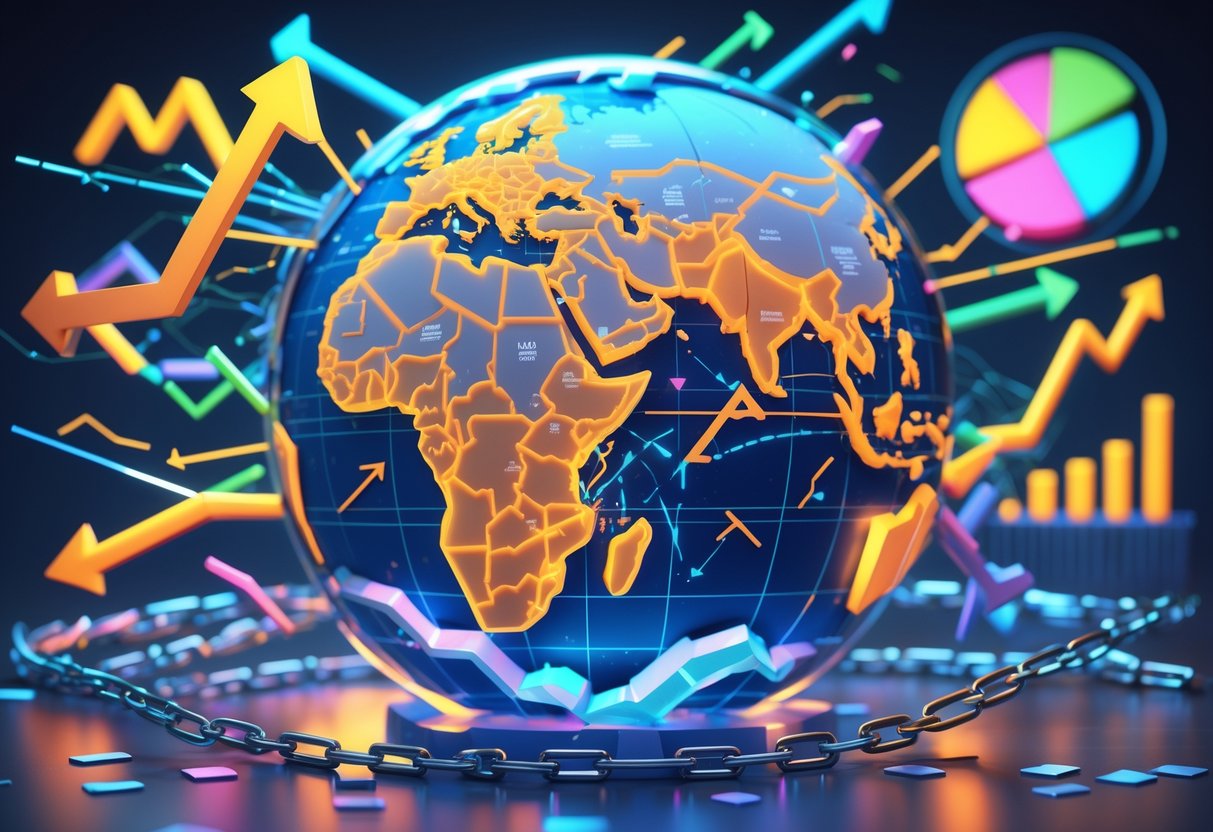
Economic sanctions have become a go-to weapon in today’s geopolitical fights. These restrictions force entire regions to rethink their trade relationships and alliances.
Sanctions don’t just hit the target country—they send shockwaves that can reshape power balances across continents.
Use as a Tool for Influence
Nations use economic sanctions to pressure rivals without going to war. These sanctions block trade, freeze assets, and cut financial ties with targeted countries.
The United States leads the way in using sanctions, often targeting Russia, Iran, and North Korea. The European Union usually coordinates restrictions with its Western allies.
Key sanctions mechanisms include:
- Trade bans on specific goods
- Financial system exclusions
- Asset freezes on individuals
- Technology transfer restrictions
Sanctions push targeted nations to seek new trading partners. That opens the door for countries willing to keep economic ties despite Western pressure.
Sanctions hit hardest when they target sectors where countries aren’t competitive. The adjustment period often shapes the long-term economic fallout more than the final restrictions.
Regional powers like China and India often step in as alternative partners. This shift can boost South-South economic cooperation and chip away at Western influence.
Recent Examples and Outcomes
The 2022 sanctions on Russia after the Ukraine invasion show how economic restrictions can reshape entire regions. European countries scrambled to replace Russian energy, turning to the Middle East and North America.
Major regional shifts include:
| Region | Impact | New Partnerships |
|---|---|---|
| Europe | Energy crisis, inflation | US LNG, Gulf states |
| Asia | Supply chain disruption | Regional trade growth |
| Middle East | Increased energy demand | Stronger ties with Europe |
Iran’s experience with sanctions has driven it to realign regionally. Tehran built closer ties with China, Russia, and its neighbors to bypass Western financial systems.
North Korea’s isolation pushed it into deeper dependence on China. This gave Beijing more influence over Pyongyang’s decisions.
Sanctions tend to fragment global economic cooperation, and rarely hit their political targets. They often speed up the rise of alternative economic blocs and erode Western dominance.
Cities with strong global connections tend to weather trade wars better. Local networks and diverse partnerships help regions adapt to new restrictions.
Alliance Shifts and New Defence Partnerships
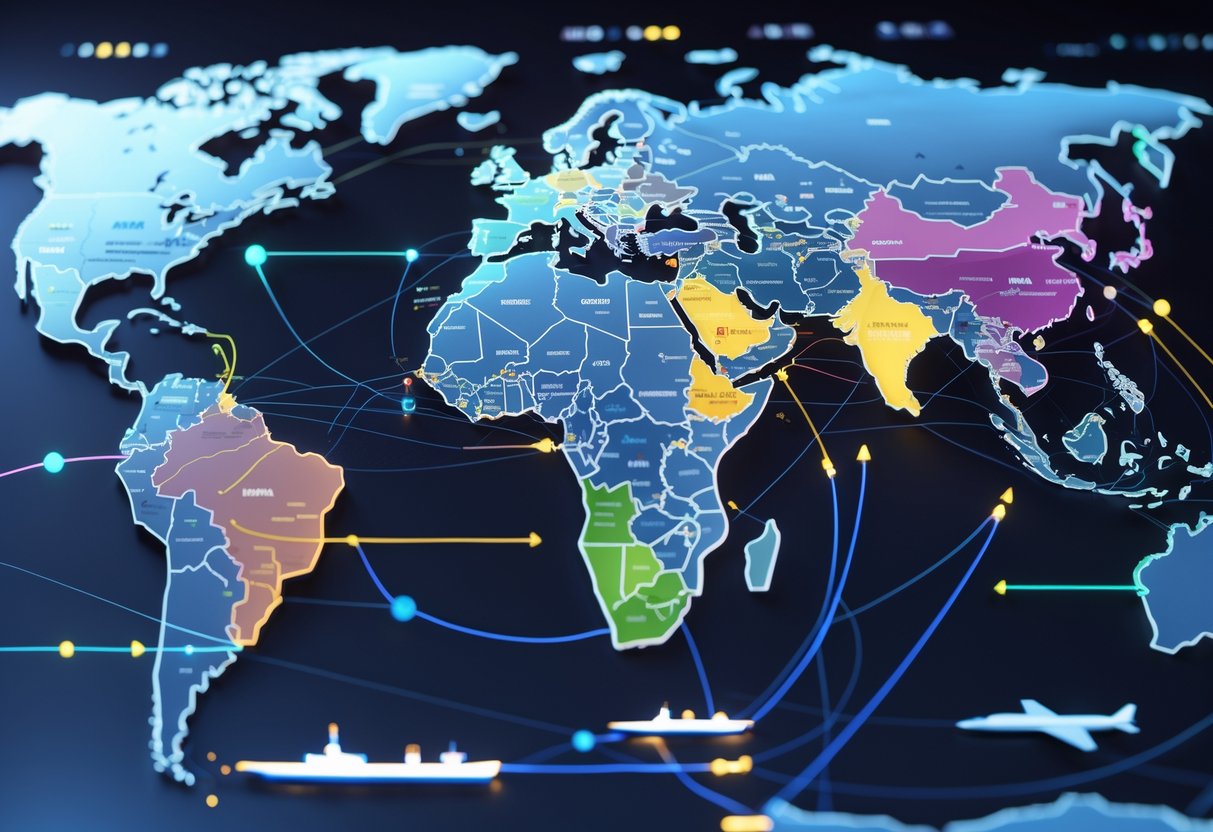
Traditional military alliances are shifting as new partnerships emerge between unexpected countries. Nations now share advanced weapons technology outside old frameworks like NATO, and arms sales are creating strategic dependencies that sometimes matter more than treaties.
Emergence of Non-Traditional Alliances
Military partnerships don’t always follow the old playbook anymore. These days, countries form defence ties based on regional interests, not just ideology.
Turkey is a good example. Even though Turkey is a NATO member, it bought Russian S-400 missile systems. That move caused major tension with the United States, which then kicked Turkey out of the F-35 fighter program.
The Middle East is seeing even bigger changes. Saudi Arabia and the UAE are strengthening defence ties with South Korea and France, hoping to rely less on American weapons.
Some new partnerships making waves:
- India-France defence cooperation (Rafale jets, submarine tech)
- Australia-UK submarine deal (skipping traditional US suppliers)
- Poland-South Korea arms agreements worth £12 billion
- Gulf states working with European defence firms
These partnerships often skip traditional alliance structures. Countries pick partners for their technology, not just political alignment.
This shift shows a growing distrust in superpower commitments. Many nations want multiple defence suppliers so they aren’t left stranded during political disputes.
Military Technology Sharing
Advanced weapons tech now moves between countries that never used to be allies. That’s changing power dynamics across regions.
Israel leads in sharing cyber warfare and missile defence technology. Countries like India, Singapore, and several in Europe have bought Israeli systems. That gives Israel influence way beyond its borders.
NATO faces headaches as members buy weapons from non-alliance sources. When Turkey bought Russian missiles, it raised security risks—Russian systems could spy on NATO operations.
Technology transfer deals usually include training and maintenance. That creates long-term ties between militaries. French technicians work with Indian submarine crews, and South Korean engineers train Polish tank operators.
Major trends in tech sharing:
- Drone tech (Turkey selling to Ukraine, Libya)
- Missile defence systems (Israel’s Iron Dome variants)
- Cyber warfare exports (Israel and South Korea lead)
- Naval tech (France-Australia, UK-Australia deals)
These partnerships sometimes clash with existing alliances. The AUKUS submarine deal, for example, angered France—a key NATO ally—after Australia cancelled a massive French contract.
Role of Arms Sales
Arms sales now shape regional power more than some treaties. Countries use weapons exports to build influence and create dependencies.
Russia has played this game across Africa and Asia. Countries that buy Russian weapons often support Moscow on global issues. India’s huge Russian arms imports help explain its neutral stance on Ukraine.
China is doing the same, using arms sales to build partnerships. Pakistan, Bangladesh, and several African nations now rely heavily on Chinese weapons. That gives Beijing serious leverage over their foreign policy.
Major arms sale relationships:
- Russia to India (60% of Indian weapons imports)
- US to Saudi Arabia (£85 billion in pending deals)
- China to Pakistan (JF-17 fighters, naval vessels)
- France to Egypt (Rafale jets, naval systems)
Arms sales create long-term dependencies. A country buying fighter jets needs decades of spare parts and technical support, so sellers keep their influence.
The economic impact goes beyond just military power. Big arms sales often come with industrial partnerships—like South Korea’s deal with Poland, which includes tech transfer and local production.
Future Prospects for Global Stability and Regional Order
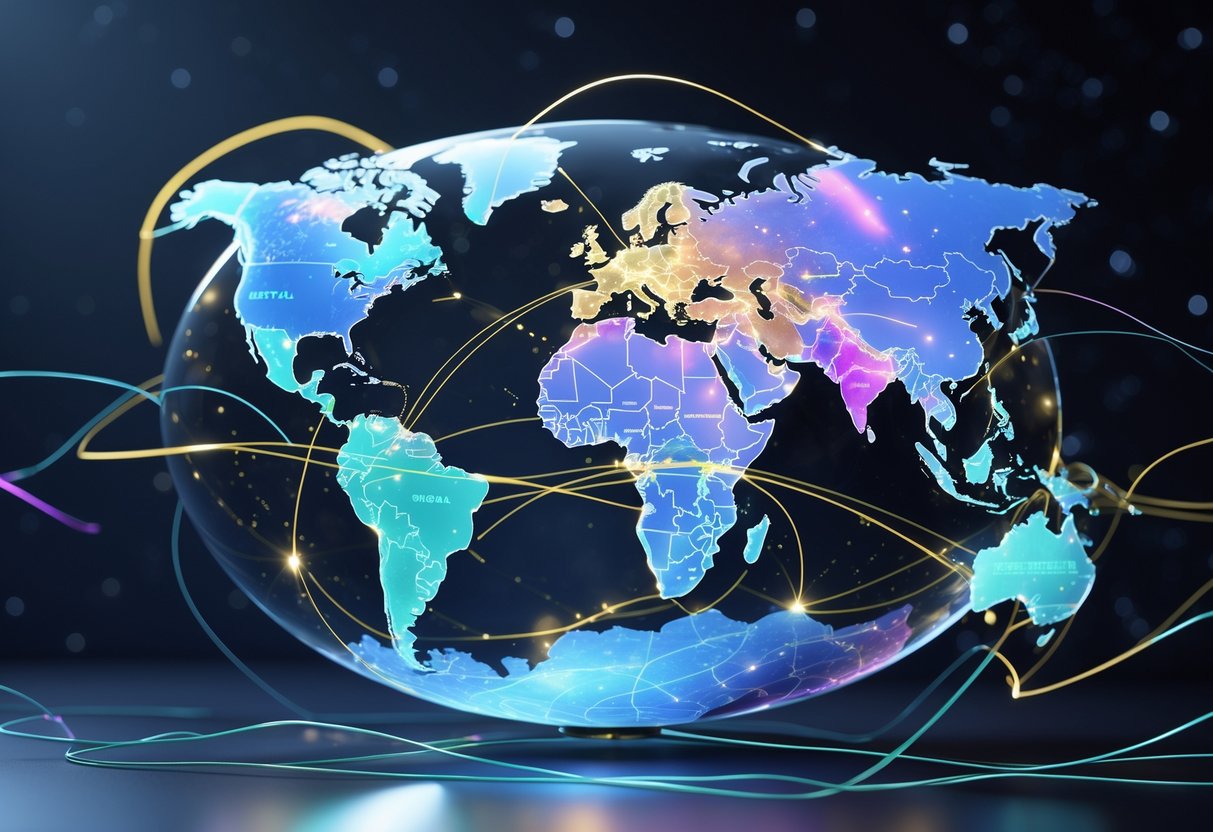
The world’s heading into a tricky transition where old power structures are giving way to messy, multipolar arrangements. Most experts expect loose multipolarity, not a new Cold War, but regional tensions and tech surprises could still shake global stability.
Predicted Trends to 2030
The global order will probably split into a tripolar structure led by the United States, China, and Europe. Each will shape its own economic and political sphere, rather than fighting head-to-head.
Regional powers like India, Japan, Germany, France, and the UK will get more independent influence. Their foreign policies will dilute both American and Chinese dominance.
Key tech developments changing the military balance:
- Hypersonic weapons (conventional and nuclear)
- Autonomous systems
- Synthetic biology
Space is shaping up to be a new battleground for grey zone competition. Military showdowns in orbit seem more likely as nations chase strategic advantages.
U.S. alliances should stay steady in Europe, but they’ll probably get shakier in Asia and the Middle East. Regional partnerships may depend on whether countries see American leadership as better than Chinese influence—or if they’d rather stay non-aligned.
The China-Russia relationship might cool off from its current high. Russia could end up balancing between China and America, depending on what it thinks benefits it most.
Potential for Increased Cooperation
There’s still some room for the big powers to cooperate where interests overlap. The U.S. and China can work together if American influence is at least equal to China’s in a region.
Possible areas for collaboration:
- Strategic stability talks
- Arms control
- Climate change responses
- Pandemic preparedness
Multilateral engagement probably remains America’s best bet for influence. When the U.S. works through alliances, other nations often figure it’s better to back American leadership than go with China.
Regional organizations will matter more as global institutions lose steam. The UN, IMF, and WTO are fading after decades of Western dominance.
European unity could help stabilize things between the U.S. and China. A strong, independent Europe gives middle powers another option besides picking sides.
Economic interdependence still encourages cooperation, even when politics get tense. Trade and supply chains connect rivals and keep some dialogue going.
Risks of Escalation and Conflict
Russia poses the biggest threat to global stability, even though its economy is weaker than before. Moscow will likely keep up disruptive “spoiler” moves against American interests.
Iran gets more aggressive when it senses the U.S. is less committed to Middle Eastern security. Tehran’s ambitions directly challenge U.S. allies in the Gulf.
North Korea keeps expanding its weapons program, and only seems open to talks when America looks strong and China looks weak.
Risks of accidental escalation are rising:
- Space warfare accidents
- Cyber attacks on key infrastructure
- Military AI system glitches
- Nuclear command failures
Grey zone activities will ramp up as adversaries hunt for political wins while dodging outright war. These tactics often hit areas where America struggles to respond.
The risk of conventional or nuclear conflict climbs as American influence slips. Power vacuums tempt rivals to act aggressively.
Violent extremist groups will exploit any sign of American weakness or withdrawal. They get bolder and more organized when U.S. cooperation with local partners fades.
Frequently Asked Questions
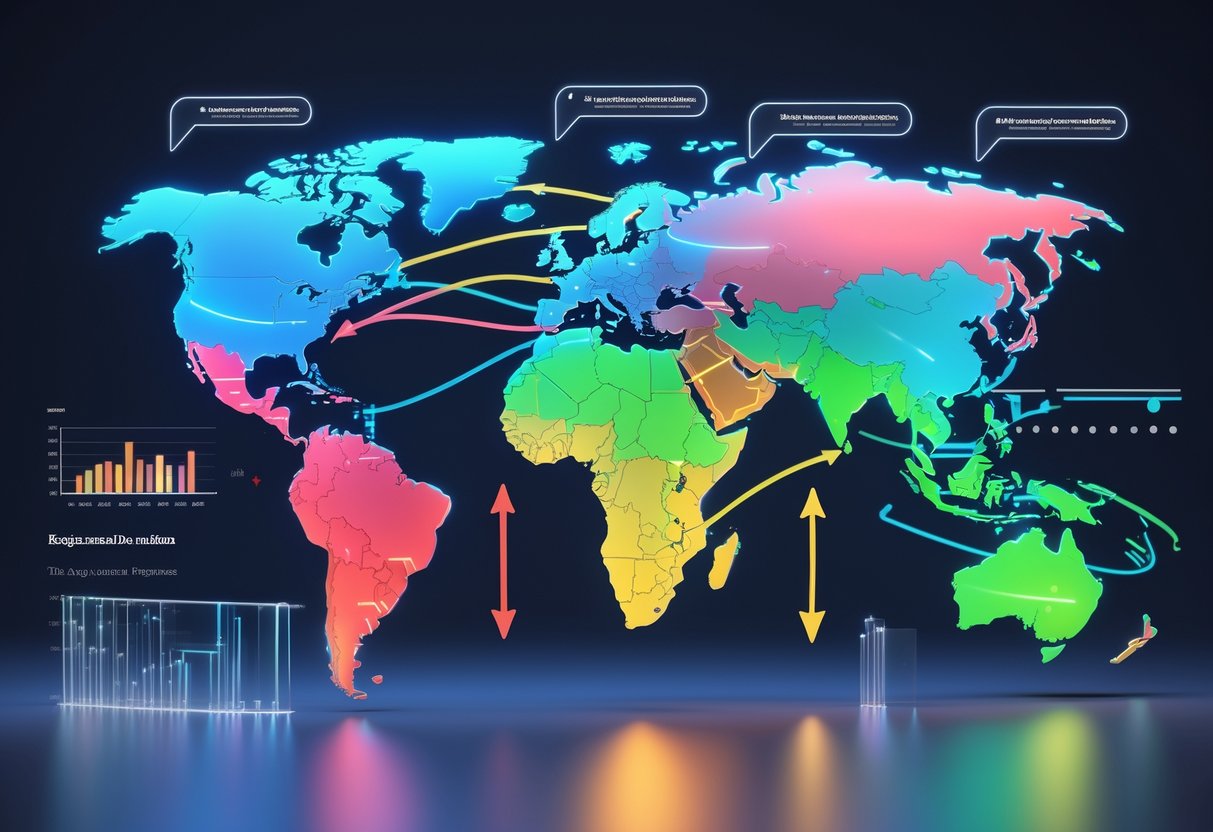
Understanding regional dominance shifts means looking at how economic growth, military power, and technology reshape global influence. These changes impact everything from trade routes to diplomatic ties.
What factors signal a shift in international power balances?
Economic growth is the clearest sign. When countries like China see rapid GDP gains, they get more resources for military and big infrastructure projects.
Military spending tends to rise after economic success. Nations building new navies or advanced weapons are clearly aiming to project power.
Changes in trade partnerships show shifting alliances. Countries that set up new economic corridors or join different trade blocs are moving away from old power centers.
Currency adoption matters, too. When nations start trading in yuan instead of dollars, it signals less reliance on US-led financial systems.
How might emerging economies influence future global leadership?
Emerging economies are building their own international institutions. The Asian Infrastructure Investment Bank and BRICS bank offer financing outside Western control.
Regional trade deals like the Regional Comprehensive Economic Partnership connect Asian economies without needing US involvement.
Tech development in these markets means less dependence on Western innovation. Countries building their own chip industries and payment systems gain strategic freedom.
Population trends also help. Younger, growing populations give emerging economies a workforce edge over aging developed nations.
What are the indicators of a declining superpower?
Military overstretch is a big red flag. If a superpower can’t keep up with commitments worldwide, allies start looking elsewhere for security.
High government debt limits what a country can spend on infrastructure and military upgrades.
Alliance cracks show weakening leadership. When old allies start acting independently or join rival partnerships, superpower influence drops.
Cultural influence slips, too. If fewer people around the world watch a superpower’s movies or shows, its soft power is fading.
How do geopolitical events affect regional control and influence?
Wars can speed up power transitions by exposing military weaknesses. Long conflicts drain resources and show rivals where the cracks are.
Economic crises give emerging powers a chance to expand influence. Offering financial help during hard times can build lasting ties.
Natural disasters test governments and international response. Countries that deliver effective aid boost their regional credibility.
Trade disputes force nations to pick sides. These choices can lead to lasting changes in economic and political alignments.
In what ways could technological advancements alter power dynamics between nations?
AI development gives countries new economic and military advantages. Leaders in AI research can boost everything from manufacturing to surveillance.
Space technology matters more now, with satellite communications and navigation systems. Countries with independent space programs rely less on foreign infrastructure.
Renewable energy changes the old resource-based power game. Nations investing in solar and wind need less from oil-rich regions.
Cyber warfare lets smaller countries punch above their weight. Advanced digital attacks can disrupt critical infrastructure without starting a traditional war.
What role does economic development play in the rise of new regional leaders?
Manufacturing capacity shapes who really controls the global supply chain. When countries set up advanced production facilities, they tend to draw in international investment and create dependencies.
Infrastructure investment can stretch a country’s influence. Railways, ports, and digital networks connect neighbors directly to the economic systems of these rising powers.
If a nation puts more effort into its education system, it gains a human capital edge. By investing in universities and technical training, countries build workforces that can handle advanced manufacturing and services.
A strong financial system lets a country flex its muscles through lending and investment. When banks are solid, they can offer development finance to nearby countries, building economic ties that often lead to more political clout.

